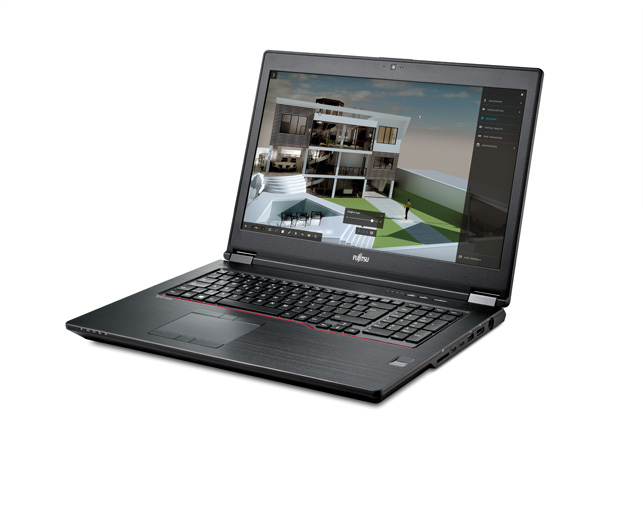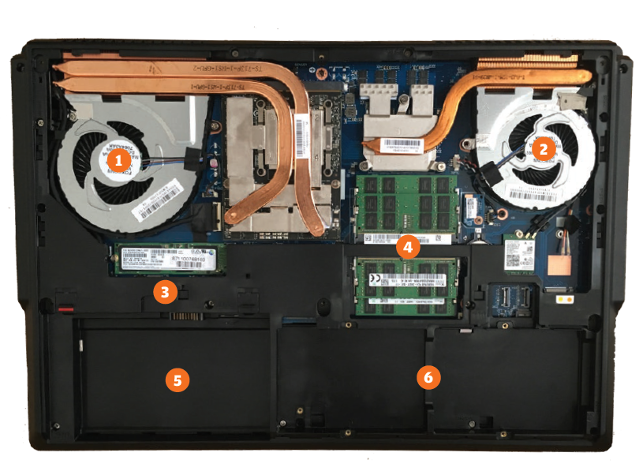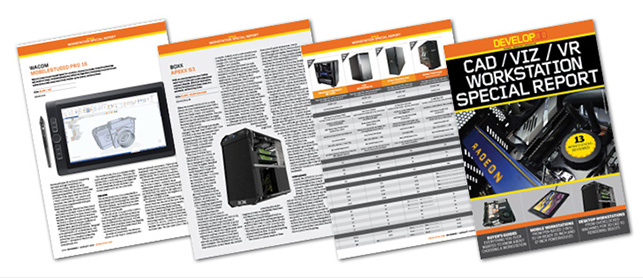Fujitsu Celsius H970 – Fujitsu’s new 17.3-inch mobile workstation offers incredible power for demanding VR and viz workflows but the CPU cooling fan can be a little over eager at times, writes Greg Corke
For some years now, Fujitsu has been relatively inactive on the mobile workstation front. Most OEMs offer three or four different models (HP actually has six), but until recently, the German-based manufacturer only had a single mobile workstation – a 15-inch machine.

15-inch mobile workstations are fine for 3D CAD, but they can only support a mid-range GPU, so often fall short in more challenging 3D workflows. Historically, demand has come from users of traditional design viz applications like 3ds Max or Maya (and perhaps a little cheeky gaming after hours). However, more recently, the need for a more powerful GPU has come from additional areas including game engine visualisation, GPU rendering and Virtual Reality (VR).
In order to support these new designfocused, GPU-hungry workflows, Fujitsu has added a 17-inch mobile workstation to its portfolio — the Fujitsu Celsius H970. The larger chassis provides the thermal headroom for a significantly more powerful GPU, as well as accommodating a bigger display.
The Fujitsu Celsius H970 comes with a choice of three pro-grade GPUs. The Quadro P4000 (8GB) and P5000 (16GB) are both powerful, VR Ready and virtually identical to their desktop counterparts. Alternatively, for those who want the benefits of a larger screen but don’t necessarily need buckets of GPU power, there’s the Nvidia Quadro P3000 (6GB). To put all of this into perspective, most 15-inch mobile workstations are limited to the 3D CAD-centric Nvidia Quadro M2200 (4GB), which is a whole GPU class below.
To show off its peak capabilities, our test machine came with the top-end Quadro P5000. This 100W GPU is partnered with a more mainstream CPU – the Quad Core, Intel Core i7-7820HQ (2.9GHz – 3.9GHz Turbo), common in both 15-inch and 17- inch mobile workstations. For those that need a bit more oomph, the H970 can also accommodate the Intel Xeon E3-1535M v6 (3.1GHz – 4.2GHz Turbo).
Memory is maxed out at 64GB of 2,133 MHz DDR4, distributed over four 16GB SO DIMMs, which is plenty for most design workflows.
For storage, there’s a solitary 512GB M.2 NVMe SSD – the popular Samsung SM961, also available in 256GB or 1TB models.
Those who want more capacity (or a lower cost per GB) can add one or two 2.5-inch SATA Hard Disk Drives (HDDs), but it seems these are best specified at time of purchase as our test machine did not come with any mounting brackets or cables – just the space within the chassis.
Fujitsu Celsius H970 – product specifications
■ Intel Core i7-7820HQ (2.9GHz, 3.9GHz Turbo) (4 cores, 8 threads)
■ 64GB (4 x 16GB) DDR4 2,133 MHz
■ Nvidia Quadro P5000 (16GB) (376.33 driver)
■ 512GB M.2 NVMe SSD
■ 17.3-inch anti-glare IPS FHD (1,920 x 1,080)
■ 418 x 288 x 30mm 3.30kg
■ Microsoft Windows 10 Pro
■ 3 Year Collect & Return Service
CPU benchmarks (single threaded) Seconds (smaller is better)
SolidWorks 2015 IGES export (single threaded): 116
CPU benchmarks (single threaded) Seconds (smaller is better)
Luxion KeyShot 6.1 render test (multi threaded): 884
V-Ray render benchmark (CPU) (multi threaded): 181
GPU compute benchmark Seconds (smaller is better)
V-Ray render benchmark (GPU): 106
3D graphics benchmarks (3D CAD) Score (bigger is better)
SPECapc for SolidWorks 2015 (shaded + edges): 5.28 (test run at FHD)
SPECapc for SolidWorks 2015 (RealView + shadows): 9.31 (test run at FHD)
SPECapc for SolidWorks (RealView + shadows + AO): 26.11 (test run at FHD)
SPECapc for PTC Creo 3.0 (shaded + edges): 9.05 (test run at FHD)
SPECapc for PTC Creo 3.0 (reflection): 12.18 (test run at FHD)
3D graphics benchmarks (design viz) Frames Per Second (FPS) (bigger is better)
LumenRT (hotel model) (FPS): 49 (test run at FHD)
LumenRT (roundabout model): 22 (test run at FHD)
Autodesk LIVE (Villa Enhanced model): 137 (test run at FHD)
Autodesk VRED Professional (AA off): 56 (test run at FHD)
Autodesk VRED Professional (AA medium): 31 (test run at FHD)
Autodesk VRED Professional (AA ultra high ): 14 (test run at FHD)
3D graphics benchmarks (VR) Frames Per Second (FPS) (bigger is better)
VR Mark (Orange): 165 (VR resolution
VR Mark (Blue): 31.9 (VR resolution)
VR Mark (Cyan): N/A








